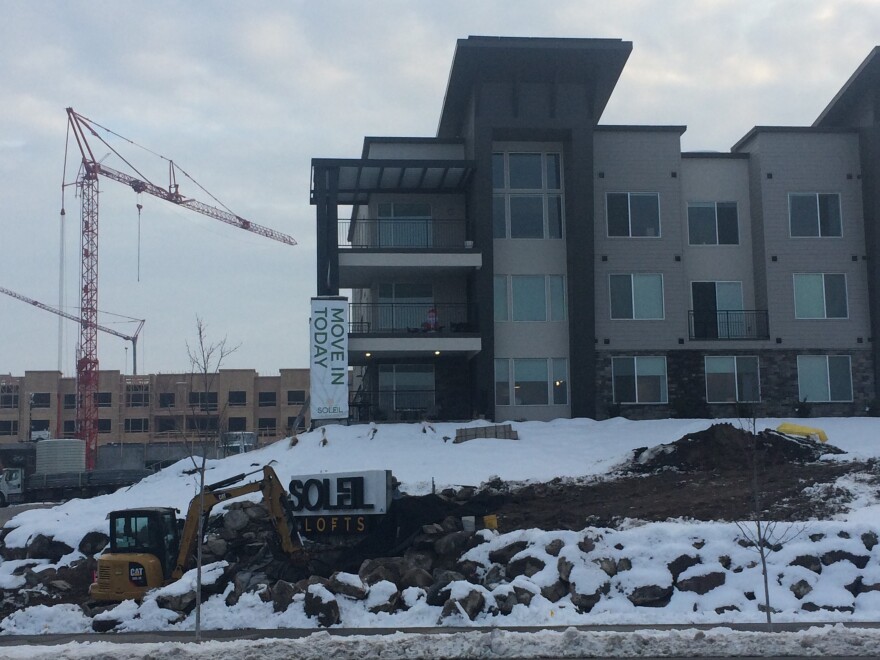HERRIMAN — When Aurora and Seth McCausland went looking for a new apartment for their growing family, they wanted a place with the trappings of modern life.
They found something they liked in the Soleil Lofts, a new development with high-end appliances and floor-to-ceiling windows that offer a sweeping view of the Wasatch. But the main draw for the McCauslands was the sleek white box in the middle of their living room.
“We always have people ask us about it when they come over. They always think it’s a fridge or something,” Seth McCausland said.
It’s actually a state-of-the-art battery that stores power generated by solar panels on the roof. Both amenities come standard with each unit, which makes living at the Soleil Lofts carbon neutral — and also a bit more expensive than similarly sized apartments in the area.
But to Aurora McCausland, the clean energy component is worth the extra cost.
“The inversion is so bad, and wintertime is so bad in Utah,” she said. “We loved the idea of moving somewhere where it’s doing something good for the environment.”

Those environmental benefits go beyond the McCausland’s apartment walls. The development also offers a potential glimpse of Utah’s energy future and signals a major shift in the way Utahns use the grid and source their energy.
What makes the Soleil Lofts unique is that Rocky Mountain Power, Utah’s largest energy provider, controls the battery inside each unit. The idea is to make the stored energy available when and where it’s needed, and in turn, the apartment complex works as a virtual power plant. A network of small generators produce power locally instead of far away at a centralized coal plant — which may soon be going away.
By 2038, Rocky Mountain Power’s parent company, PacifiCorp, expects to retire 20 of its 24 coal-fired plants. In their place, the utility will embrace a large portfolio of renewables — more than 10,900 megawatts of wind and solar. For the first time, PacifiCorp’s plans also include battery storage.
Adding an influx of renewables means the utility will need more flexibility to move power around its transmission lines. That’s where the Soleil Lofts comes in.
The complex is still under construction, but plans call for 600 units, making Soleil Lofts the largest project of its kind in the West and one of the first virtual power plants built from the ground up.
“What we’re talking about is this energy consumer that’s allowing us to utilize our grid much more efficiently,” said Bill Comeau, Rocky Mountain Power’s managing director of customer innovations. “If we had more and more of these types of things … we wouldn’t have to build as many renewable plants out there, we wouldn’t have to increase our transmission lines.”
'The Right Thing For Humanity'
Soleil Lofts wasn’t conceived of as a virtual power plant. The Wasatch Group, the project’s developer, initially wanted to create a complex that was completely off-grid and self-sustaining.
“What we realized, the further we looked into it, is that’s really the polar opposite of what we’d really need to do to do the right thing for humanity,” said Jarom Johnson, director of the Wasatch Group residential division.
Building an apartment complex that’s off-grid isn’t practical in northern Utah, either. Solar panels produce less energy in the winter, especially when there’s an inversion layer.
By connecting with the utility, however, residential solar generators can charge their batteries when sunlight is low and supplement the grid when demand for power is high.
The batteries at Soleil Lofts could also solve a problem that has plagued Rocky Mountain Power since rooftop solar began soaring in popularity.
Back in 2016, the utility clashed with rooftop solar enthusiasts as it lobbied against net metering and altered the way homeowners are compensated for the energy they produce. Opponents of the change say it’s now harder to pay off solar panels, which discourages more installations. The utility claims residential solar panels produce power at the wrong time of day.
“They’re sending it back to us when we don’t need the power, but then they’re still pulling from us in the middle of the summer when their solar system isn’t producing enough to run their air conditioning,” said James Campbell, Rocky Mountain Power’s policy and projects adviser.
Under past net metering regulations, the utility had to pay for residential solar power whether it needed it or not. That meant non-solar ratepayers subsidized the utility’s 37,000 net metering customers, Campbell said.
With the utility-controlled battery storage at Soleil, “we don’t see that same phenomenon,” he said.
A Good Grid Citizen
Developments like the Soleil Lofts are a small component of the future grid. PacifiCorp will still need to build utility-scale solar projects and giant wind farms to meet demand. But distributed energy projects can make the future grid more resilient.
Using home-based technologies like solar panels and batteries to benefit other energy consumers is being a “good grid citizen,” according to Kate Bowman with Utah Clean Energy.
“As you have more of these technologies at your home,” Bowman said, “you can think about how to manage your energy use in a way that isn't just helping you save money on bills or helping you cut your environmental footprint but actually helps to make the grid, as a whole, more flexible.”
The Soleil Lofts project could also help PacifiCorp provide battery solutions to more of its solar customers.
Beyond living as a good grid citizen, Seth McCausland said home batteries provide a few other perks, including bragging rights.
“I like to bring it up. (People) say ‘Your apartment’s really cool.’ I’m like, ‘Yeah, but it’s also solar powered,’” he said.
Rocky Mountain Power plans to take what it learns from the Soleil Lofts project and offer home battery incentives as soon as mid-2020.
Leia Larsen is an independent journalist based in Ogden.



